Postnatal Depression: Understanding Causes, Treatments, and Statistics
VerifiedAdded on 2023/01/18
|9
|2475
|41
Report
AI Summary
This report provides an in-depth analysis of postnatal depression, a prevalent issue affecting women after childbirth. It begins with an executive summary highlighting the condition's impact and potential treatments, including medication, counseling, and hormonal therapy. The introduction defines postnatal depression and emphasizes its increasing prevalence, citing statistics on its impact and mortality rates. The literature review explores the symptoms, hormonal changes, and the significant changes women experience. The report presents statistics from various organizations like the World Health Organization, detailing the prevalence of postnatal depression across different regions and demographics, including the impact on fathers. It outlines various treatment options, including antidepressant medications, hormone therapy, and counseling, and discusses the methods used for data collection, including primary and secondary sources, and the use of questionnaires and interviews to gather data from mothers and healthcare workers. The study's results indicate the prevalence of postnatal depression among mothers and the effectiveness of psychological support in its management. The conclusion summarizes the causes, treatments, and overall impact of postnatal depression, highlighting the importance of early intervention and support for affected individuals. The report references several books and journals to support its findings.

POSTNATAL DEPRESSION
1
1
Paraphrase This Document
Need a fresh take? Get an instant paraphrase of this document with our AI Paraphraser

Executive summary
The above report includes the postnatal depression is the common problem which is
faced by women after the delivery period of her. The women face major depression after
pregnancy. It can be treated by anti-depressing medication, counselling and hormonal therapy.
Nearly 30% of women die due to this and in some cases father are also affected due to this.
2
The above report includes the postnatal depression is the common problem which is
faced by women after the delivery period of her. The women face major depression after
pregnancy. It can be treated by anti-depressing medication, counselling and hormonal therapy.
Nearly 30% of women die due to this and in some cases father are also affected due to this.
2
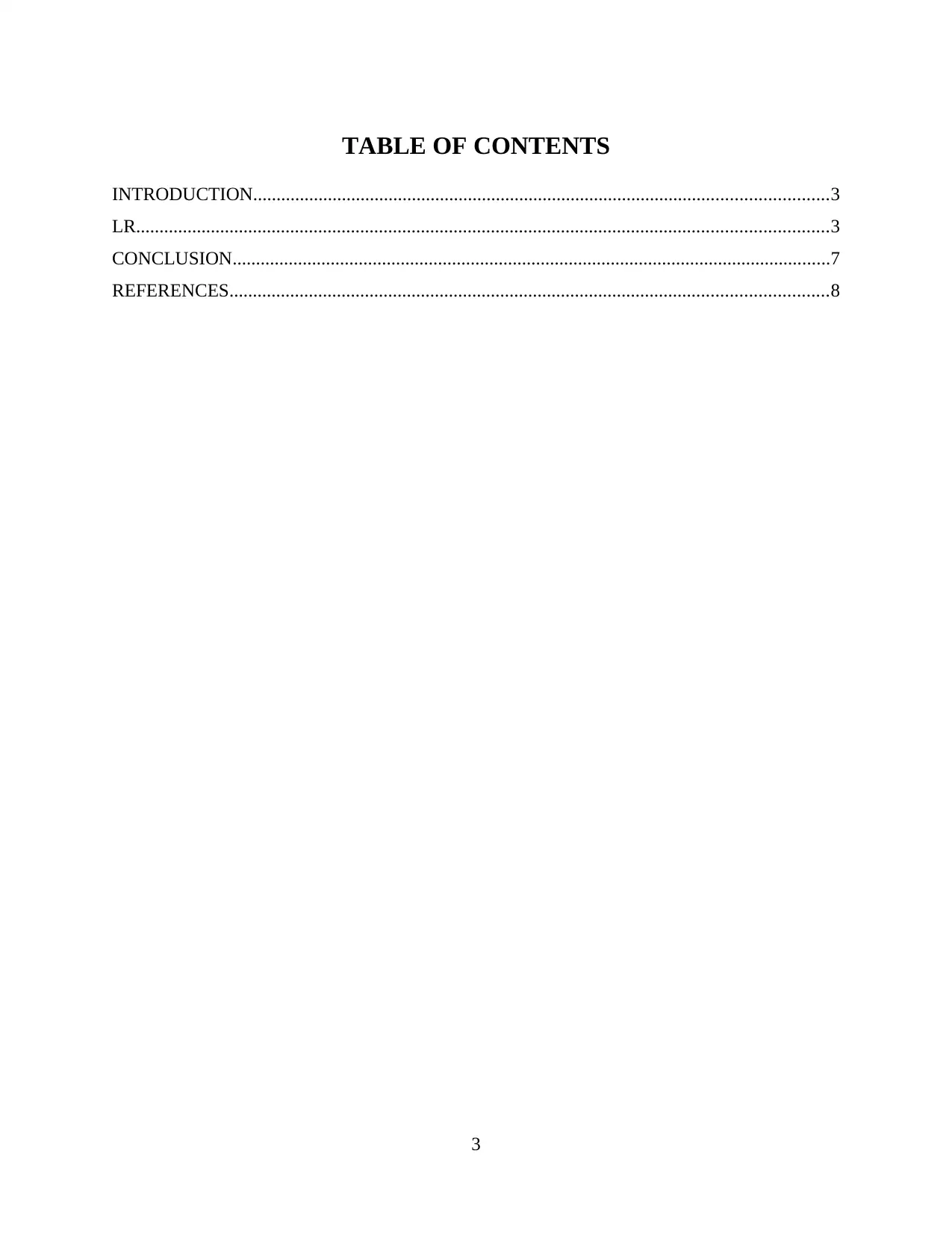
TABLE OF CONTENTS
INTRODUCTION...........................................................................................................................3
LR....................................................................................................................................................3
CONCLUSION................................................................................................................................7
REFERENCES................................................................................................................................8
3
INTRODUCTION...........................................................................................................................3
LR....................................................................................................................................................3
CONCLUSION................................................................................................................................7
REFERENCES................................................................................................................................8
3
⊘ This is a preview!⊘
Do you want full access?
Subscribe today to unlock all pages.

Trusted by 1+ million students worldwide
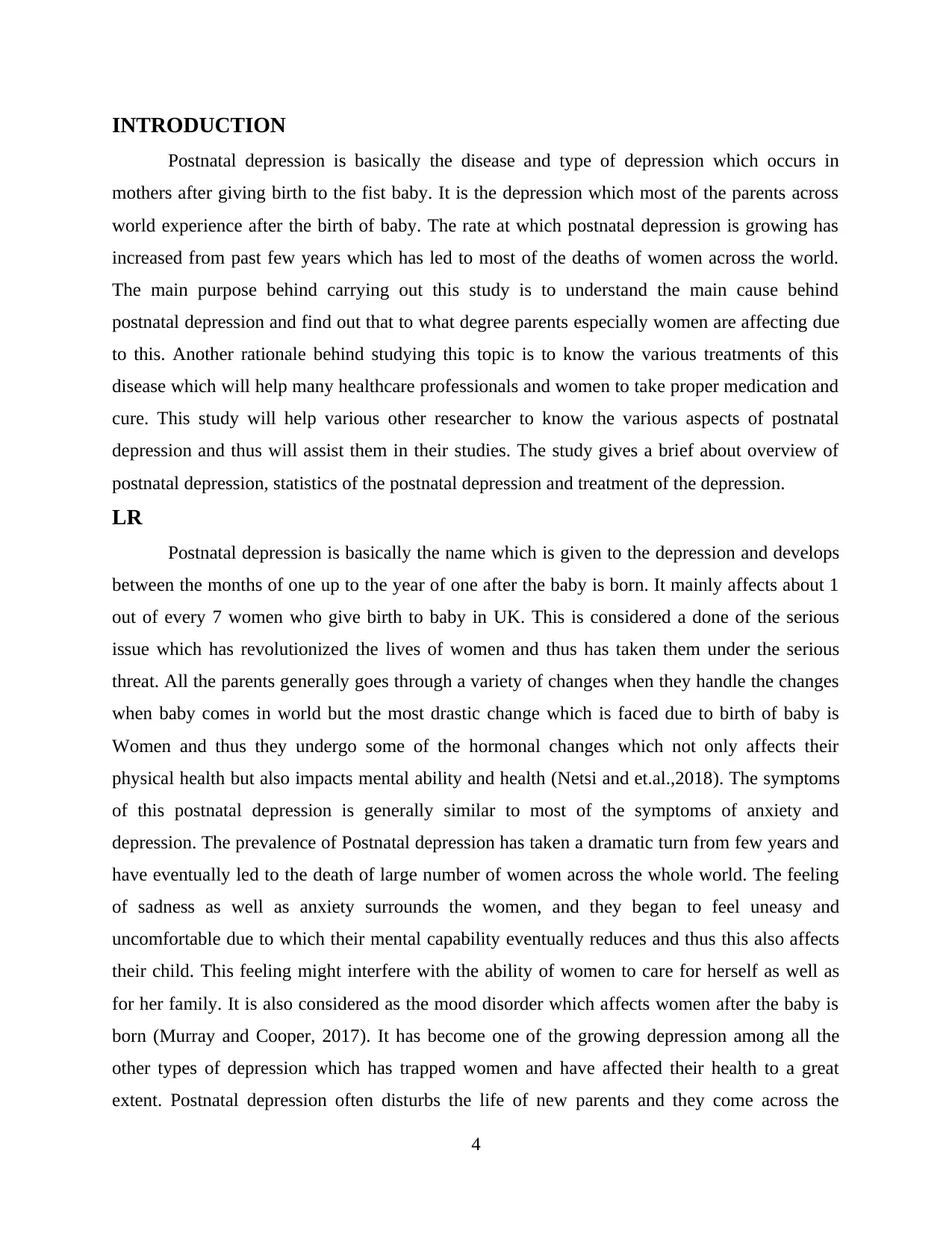
INTRODUCTION
Postnatal depression is basically the disease and type of depression which occurs in
mothers after giving birth to the fist baby. It is the depression which most of the parents across
world experience after the birth of baby. The rate at which postnatal depression is growing has
increased from past few years which has led to most of the deaths of women across the world.
The main purpose behind carrying out this study is to understand the main cause behind
postnatal depression and find out that to what degree parents especially women are affecting due
to this. Another rationale behind studying this topic is to know the various treatments of this
disease which will help many healthcare professionals and women to take proper medication and
cure. This study will help various other researcher to know the various aspects of postnatal
depression and thus will assist them in their studies. The study gives a brief about overview of
postnatal depression, statistics of the postnatal depression and treatment of the depression.
LR
Postnatal depression is basically the name which is given to the depression and develops
between the months of one up to the year of one after the baby is born. It mainly affects about 1
out of every 7 women who give birth to baby in UK. This is considered a done of the serious
issue which has revolutionized the lives of women and thus has taken them under the serious
threat. All the parents generally goes through a variety of changes when they handle the changes
when baby comes in world but the most drastic change which is faced due to birth of baby is
Women and thus they undergo some of the hormonal changes which not only affects their
physical health but also impacts mental ability and health (Netsi and et.al.,2018). The symptoms
of this postnatal depression is generally similar to most of the symptoms of anxiety and
depression. The prevalence of Postnatal depression has taken a dramatic turn from few years and
have eventually led to the death of large number of women across the whole world. The feeling
of sadness as well as anxiety surrounds the women, and they began to feel uneasy and
uncomfortable due to which their mental capability eventually reduces and thus this also affects
their child. This feeling might interfere with the ability of women to care for herself as well as
for her family. It is also considered as the mood disorder which affects women after the baby is
born (Murray and Cooper, 2017). It has become one of the growing depression among all the
other types of depression which has trapped women and have affected their health to a great
extent. Postnatal depression often disturbs the life of new parents and they come across the
4
Postnatal depression is basically the disease and type of depression which occurs in
mothers after giving birth to the fist baby. It is the depression which most of the parents across
world experience after the birth of baby. The rate at which postnatal depression is growing has
increased from past few years which has led to most of the deaths of women across the world.
The main purpose behind carrying out this study is to understand the main cause behind
postnatal depression and find out that to what degree parents especially women are affecting due
to this. Another rationale behind studying this topic is to know the various treatments of this
disease which will help many healthcare professionals and women to take proper medication and
cure. This study will help various other researcher to know the various aspects of postnatal
depression and thus will assist them in their studies. The study gives a brief about overview of
postnatal depression, statistics of the postnatal depression and treatment of the depression.
LR
Postnatal depression is basically the name which is given to the depression and develops
between the months of one up to the year of one after the baby is born. It mainly affects about 1
out of every 7 women who give birth to baby in UK. This is considered a done of the serious
issue which has revolutionized the lives of women and thus has taken them under the serious
threat. All the parents generally goes through a variety of changes when they handle the changes
when baby comes in world but the most drastic change which is faced due to birth of baby is
Women and thus they undergo some of the hormonal changes which not only affects their
physical health but also impacts mental ability and health (Netsi and et.al.,2018). The symptoms
of this postnatal depression is generally similar to most of the symptoms of anxiety and
depression. The prevalence of Postnatal depression has taken a dramatic turn from few years and
have eventually led to the death of large number of women across the whole world. The feeling
of sadness as well as anxiety surrounds the women, and they began to feel uneasy and
uncomfortable due to which their mental capability eventually reduces and thus this also affects
their child. This feeling might interfere with the ability of women to care for herself as well as
for her family. It is also considered as the mood disorder which affects women after the baby is
born (Murray and Cooper, 2017). It has become one of the growing depression among all the
other types of depression which has trapped women and have affected their health to a great
extent. Postnatal depression often disturbs the life of new parents and they come across the
4
Paraphrase This Document
Need a fresh take? Get an instant paraphrase of this document with our AI Paraphraser
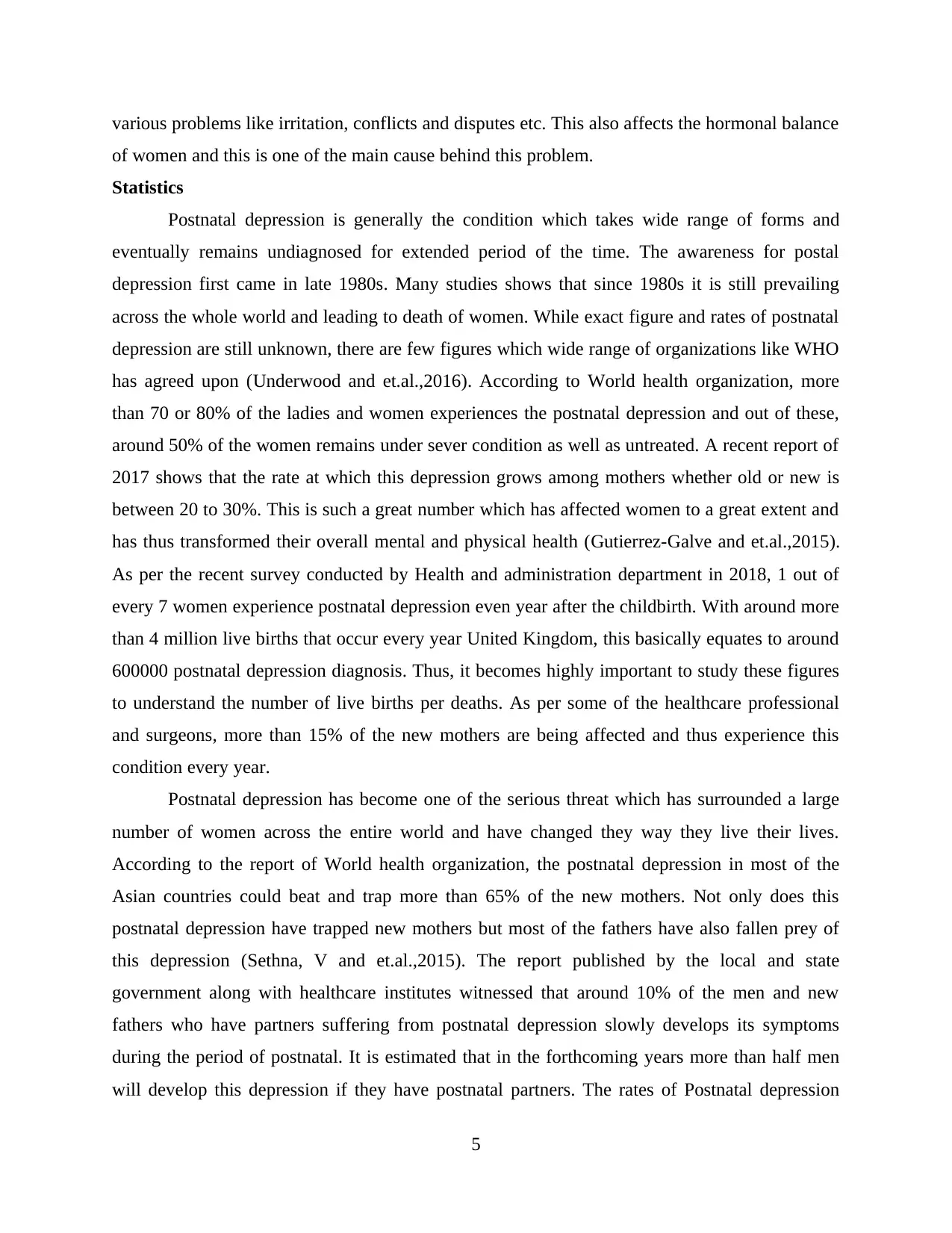
various problems like irritation, conflicts and disputes etc. This also affects the hormonal balance
of women and this is one of the main cause behind this problem.
Statistics
Postnatal depression is generally the condition which takes wide range of forms and
eventually remains undiagnosed for extended period of the time. The awareness for postal
depression first came in late 1980s. Many studies shows that since 1980s it is still prevailing
across the whole world and leading to death of women. While exact figure and rates of postnatal
depression are still unknown, there are few figures which wide range of organizations like WHO
has agreed upon (Underwood and et.al.,2016). According to World health organization, more
than 70 or 80% of the ladies and women experiences the postnatal depression and out of these,
around 50% of the women remains under sever condition as well as untreated. A recent report of
2017 shows that the rate at which this depression grows among mothers whether old or new is
between 20 to 30%. This is such a great number which has affected women to a great extent and
has thus transformed their overall mental and physical health (Gutierrez-Galve and et.al.,2015).
As per the recent survey conducted by Health and administration department in 2018, 1 out of
every 7 women experience postnatal depression even year after the childbirth. With around more
than 4 million live births that occur every year United Kingdom, this basically equates to around
600000 postnatal depression diagnosis. Thus, it becomes highly important to study these figures
to understand the number of live births per deaths. As per some of the healthcare professional
and surgeons, more than 15% of the new mothers are being affected and thus experience this
condition every year.
Postnatal depression has become one of the serious threat which has surrounded a large
number of women across the entire world and have changed they way they live their lives.
According to the report of World health organization, the postnatal depression in most of the
Asian countries could beat and trap more than 65% of the new mothers. Not only does this
postnatal depression have trapped new mothers but most of the fathers have also fallen prey of
this depression (Sethna, V and et.al.,2015). The report published by the local and state
government along with healthcare institutes witnessed that around 10% of the men and new
fathers who have partners suffering from postnatal depression slowly develops its symptoms
during the period of postnatal. It is estimated that in the forthcoming years more than half men
will develop this depression if they have postnatal partners. The rates of Postnatal depression
5
of women and this is one of the main cause behind this problem.
Statistics
Postnatal depression is generally the condition which takes wide range of forms and
eventually remains undiagnosed for extended period of the time. The awareness for postal
depression first came in late 1980s. Many studies shows that since 1980s it is still prevailing
across the whole world and leading to death of women. While exact figure and rates of postnatal
depression are still unknown, there are few figures which wide range of organizations like WHO
has agreed upon (Underwood and et.al.,2016). According to World health organization, more
than 70 or 80% of the ladies and women experiences the postnatal depression and out of these,
around 50% of the women remains under sever condition as well as untreated. A recent report of
2017 shows that the rate at which this depression grows among mothers whether old or new is
between 20 to 30%. This is such a great number which has affected women to a great extent and
has thus transformed their overall mental and physical health (Gutierrez-Galve and et.al.,2015).
As per the recent survey conducted by Health and administration department in 2018, 1 out of
every 7 women experience postnatal depression even year after the childbirth. With around more
than 4 million live births that occur every year United Kingdom, this basically equates to around
600000 postnatal depression diagnosis. Thus, it becomes highly important to study these figures
to understand the number of live births per deaths. As per some of the healthcare professional
and surgeons, more than 15% of the new mothers are being affected and thus experience this
condition every year.
Postnatal depression has become one of the serious threat which has surrounded a large
number of women across the entire world and have changed they way they live their lives.
According to the report of World health organization, the postnatal depression in most of the
Asian countries could beat and trap more than 65% of the new mothers. Not only does this
postnatal depression have trapped new mothers but most of the fathers have also fallen prey of
this depression (Sethna, V and et.al.,2015). The report published by the local and state
government along with healthcare institutes witnessed that around 10% of the men and new
fathers who have partners suffering from postnatal depression slowly develops its symptoms
during the period of postnatal. It is estimated that in the forthcoming years more than half men
will develop this depression if they have postnatal partners. The rates of Postnatal depression
5
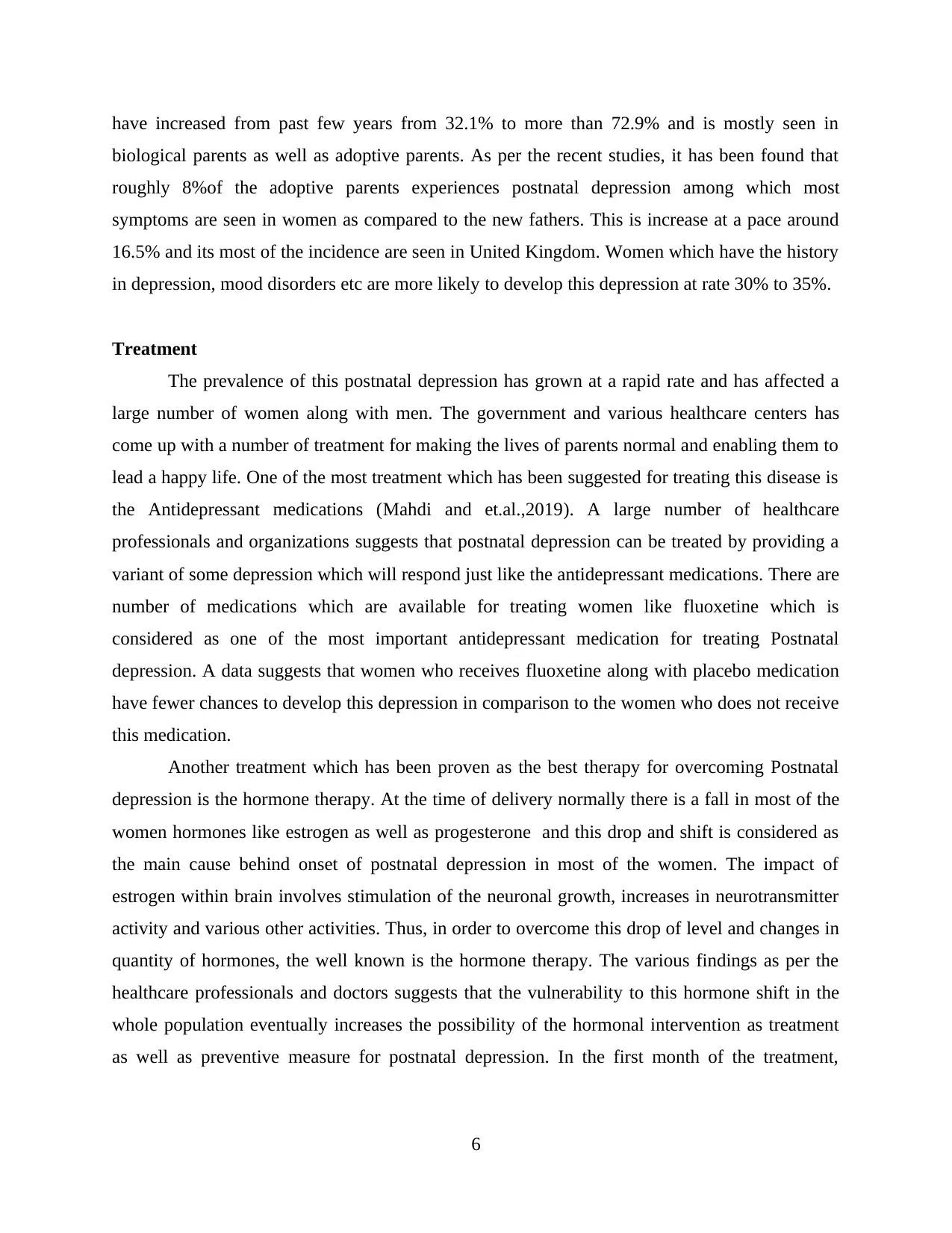
have increased from past few years from 32.1% to more than 72.9% and is mostly seen in
biological parents as well as adoptive parents. As per the recent studies, it has been found that
roughly 8%of the adoptive parents experiences postnatal depression among which most
symptoms are seen in women as compared to the new fathers. This is increase at a pace around
16.5% and its most of the incidence are seen in United Kingdom. Women which have the history
in depression, mood disorders etc are more likely to develop this depression at rate 30% to 35%.
Treatment
The prevalence of this postnatal depression has grown at a rapid rate and has affected a
large number of women along with men. The government and various healthcare centers has
come up with a number of treatment for making the lives of parents normal and enabling them to
lead a happy life. One of the most treatment which has been suggested for treating this disease is
the Antidepressant medications (Mahdi and et.al.,2019). A large number of healthcare
professionals and organizations suggests that postnatal depression can be treated by providing a
variant of some depression which will respond just like the antidepressant medications. There are
number of medications which are available for treating women like fluoxetine which is
considered as one of the most important antidepressant medication for treating Postnatal
depression. A data suggests that women who receives fluoxetine along with placebo medication
have fewer chances to develop this depression in comparison to the women who does not receive
this medication.
Another treatment which has been proven as the best therapy for overcoming Postnatal
depression is the hormone therapy. At the time of delivery normally there is a fall in most of the
women hormones like estrogen as well as progesterone and this drop and shift is considered as
the main cause behind onset of postnatal depression in most of the women. The impact of
estrogen within brain involves stimulation of the neuronal growth, increases in neurotransmitter
activity and various other activities. Thus, in order to overcome this drop of level and changes in
quantity of hormones, the well known is the hormone therapy. The various findings as per the
healthcare professionals and doctors suggests that the vulnerability to this hormone shift in the
whole population eventually increases the possibility of the hormonal intervention as treatment
as well as preventive measure for postnatal depression. In the first month of the treatment,
6
biological parents as well as adoptive parents. As per the recent studies, it has been found that
roughly 8%of the adoptive parents experiences postnatal depression among which most
symptoms are seen in women as compared to the new fathers. This is increase at a pace around
16.5% and its most of the incidence are seen in United Kingdom. Women which have the history
in depression, mood disorders etc are more likely to develop this depression at rate 30% to 35%.
Treatment
The prevalence of this postnatal depression has grown at a rapid rate and has affected a
large number of women along with men. The government and various healthcare centers has
come up with a number of treatment for making the lives of parents normal and enabling them to
lead a happy life. One of the most treatment which has been suggested for treating this disease is
the Antidepressant medications (Mahdi and et.al.,2019). A large number of healthcare
professionals and organizations suggests that postnatal depression can be treated by providing a
variant of some depression which will respond just like the antidepressant medications. There are
number of medications which are available for treating women like fluoxetine which is
considered as one of the most important antidepressant medication for treating Postnatal
depression. A data suggests that women who receives fluoxetine along with placebo medication
have fewer chances to develop this depression in comparison to the women who does not receive
this medication.
Another treatment which has been proven as the best therapy for overcoming Postnatal
depression is the hormone therapy. At the time of delivery normally there is a fall in most of the
women hormones like estrogen as well as progesterone and this drop and shift is considered as
the main cause behind onset of postnatal depression in most of the women. The impact of
estrogen within brain involves stimulation of the neuronal growth, increases in neurotransmitter
activity and various other activities. Thus, in order to overcome this drop of level and changes in
quantity of hormones, the well known is the hormone therapy. The various findings as per the
healthcare professionals and doctors suggests that the vulnerability to this hormone shift in the
whole population eventually increases the possibility of the hormonal intervention as treatment
as well as preventive measure for postnatal depression. In the first month of the treatment,
6
⊘ This is a preview!⊘
Do you want full access?
Subscribe today to unlock all pages.

Trusted by 1+ million students worldwide

women are usually exposed to this hormone therapy where a stream of estrogen as well as
progesterone is incorporated within their body to prevent the drop in level (Mah and et.al.,2017).
No matter which type of depression is and in which it is present, talking with them and
understanding their problems is the best therapy which eventually reduces their depression level
and they feel relaxed and comfortable. This is known by the name of counseling and thus is the
best medicine which helps to reduce the effect of this postnatal depression and enable the women
to lead a normal life. This treatment mainly involves talking with one another or with the
medical professionals. In this, two types of therapy are mostly given which are Cognitive
behavioral therapy. In this, the medical professional helps the parents and most women to
recognize themselves and alter their negative viewpoints as well as behaviour. Another therapy is
interpersonal therapy in which the doctors help people to understand as well as work through
various problematic personal relations (Du Preez and et.al.,2016).
Method
There are mainly two methods of data collection primary as well as secondary. In
primary source, researcher mainly gets the first hand information and is the original data.
Secondary source mainly includes the information which is being collected by someone else and
researcher gets already established data. In this report, quantitative approach has been used and
primary data has been used like questionnaire and interview (Brown, Rance and Bennett, 2016).
The study mainly includes mothers as well as the healthcare workers. Among all the techniques,
simple random sampling has been used for selecting 257 mothers while convenience sampling
method was used for selecting 56 health workers. A patient's health questionnaire was being
used for screening the depression. This consist of the structured questionnaire containing close-
ended questions which was used for collecting the primary data upon intervention for managing
Postnatal depression. Data later on was analyzed & assessed through the use of statistical
software which is SPSS version 16.0.
Results
The study carried out shows that the postnatal depression is mainly prevalent among
mothers but at low rate. Besides this, psychological support was the most efficient intervention
within its management (Murray, Fearon and Cooper, 2015). This depression might impact
socialization behaviour within children as well as mother. The study revealed that more than 7%
of mothers selected were under the threat of postnatal depression. Psychological support was
7
progesterone is incorporated within their body to prevent the drop in level (Mah and et.al.,2017).
No matter which type of depression is and in which it is present, talking with them and
understanding their problems is the best therapy which eventually reduces their depression level
and they feel relaxed and comfortable. This is known by the name of counseling and thus is the
best medicine which helps to reduce the effect of this postnatal depression and enable the women
to lead a normal life. This treatment mainly involves talking with one another or with the
medical professionals. In this, two types of therapy are mostly given which are Cognitive
behavioral therapy. In this, the medical professional helps the parents and most women to
recognize themselves and alter their negative viewpoints as well as behaviour. Another therapy is
interpersonal therapy in which the doctors help people to understand as well as work through
various problematic personal relations (Du Preez and et.al.,2016).
Method
There are mainly two methods of data collection primary as well as secondary. In
primary source, researcher mainly gets the first hand information and is the original data.
Secondary source mainly includes the information which is being collected by someone else and
researcher gets already established data. In this report, quantitative approach has been used and
primary data has been used like questionnaire and interview (Brown, Rance and Bennett, 2016).
The study mainly includes mothers as well as the healthcare workers. Among all the techniques,
simple random sampling has been used for selecting 257 mothers while convenience sampling
method was used for selecting 56 health workers. A patient's health questionnaire was being
used for screening the depression. This consist of the structured questionnaire containing close-
ended questions which was used for collecting the primary data upon intervention for managing
Postnatal depression. Data later on was analyzed & assessed through the use of statistical
software which is SPSS version 16.0.
Results
The study carried out shows that the postnatal depression is mainly prevalent among
mothers but at low rate. Besides this, psychological support was the most efficient intervention
within its management (Murray, Fearon and Cooper, 2015). This depression might impact
socialization behaviour within children as well as mother. The study revealed that more than 7%
of mothers selected were under the threat of postnatal depression. Psychological support was
7
Paraphrase This Document
Need a fresh take? Get an instant paraphrase of this document with our AI Paraphraser
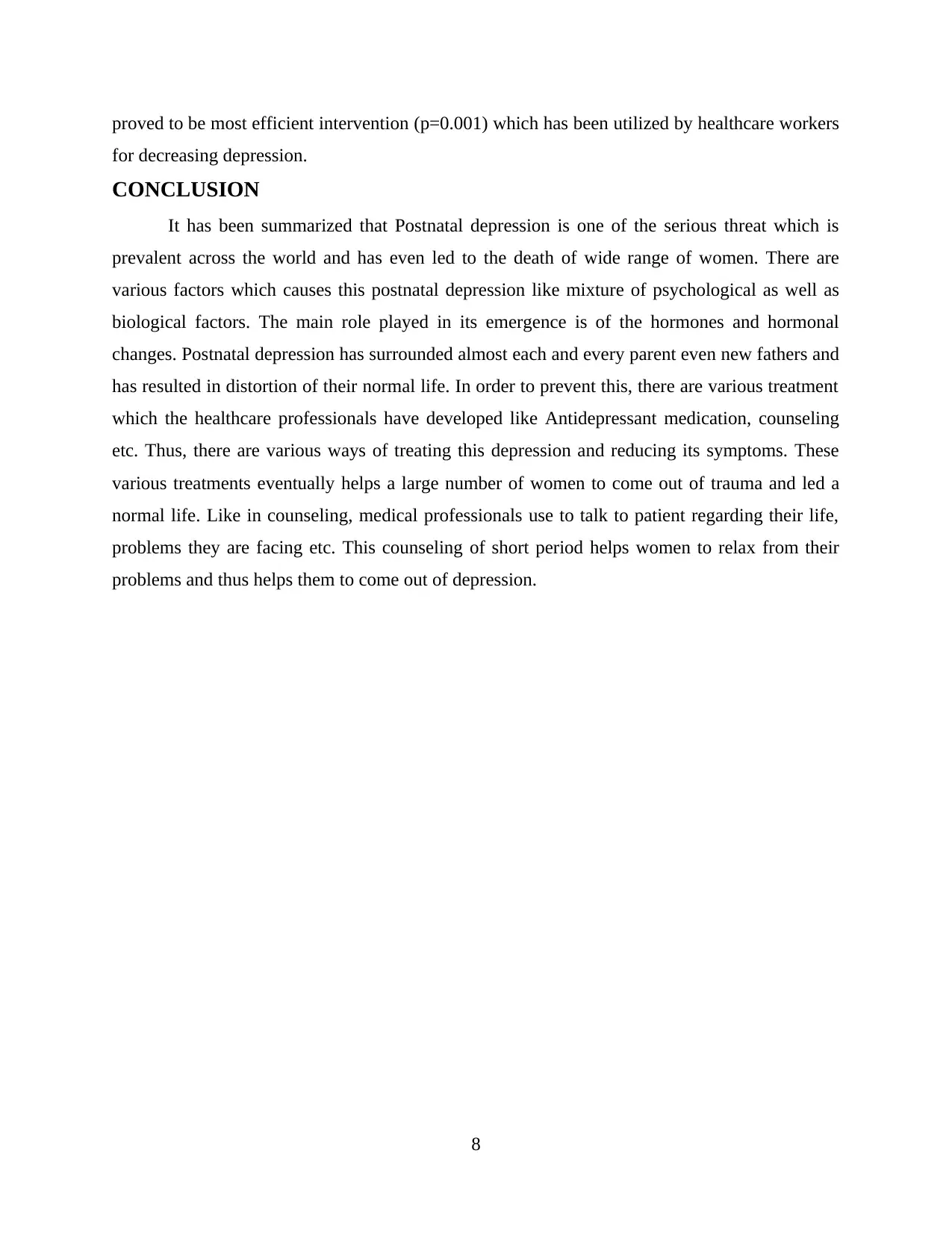
proved to be most efficient intervention (p=0.001) which has been utilized by healthcare workers
for decreasing depression.
CONCLUSION
It has been summarized that Postnatal depression is one of the serious threat which is
prevalent across the world and has even led to the death of wide range of women. There are
various factors which causes this postnatal depression like mixture of psychological as well as
biological factors. The main role played in its emergence is of the hormones and hormonal
changes. Postnatal depression has surrounded almost each and every parent even new fathers and
has resulted in distortion of their normal life. In order to prevent this, there are various treatment
which the healthcare professionals have developed like Antidepressant medication, counseling
etc. Thus, there are various ways of treating this depression and reducing its symptoms. These
various treatments eventually helps a large number of women to come out of trauma and led a
normal life. Like in counseling, medical professionals use to talk to patient regarding their life,
problems they are facing etc. This counseling of short period helps women to relax from their
problems and thus helps them to come out of depression.
8
for decreasing depression.
CONCLUSION
It has been summarized that Postnatal depression is one of the serious threat which is
prevalent across the world and has even led to the death of wide range of women. There are
various factors which causes this postnatal depression like mixture of psychological as well as
biological factors. The main role played in its emergence is of the hormones and hormonal
changes. Postnatal depression has surrounded almost each and every parent even new fathers and
has resulted in distortion of their normal life. In order to prevent this, there are various treatment
which the healthcare professionals have developed like Antidepressant medication, counseling
etc. Thus, there are various ways of treating this depression and reducing its symptoms. These
various treatments eventually helps a large number of women to come out of trauma and led a
normal life. Like in counseling, medical professionals use to talk to patient regarding their life,
problems they are facing etc. This counseling of short period helps women to relax from their
problems and thus helps them to come out of depression.
8
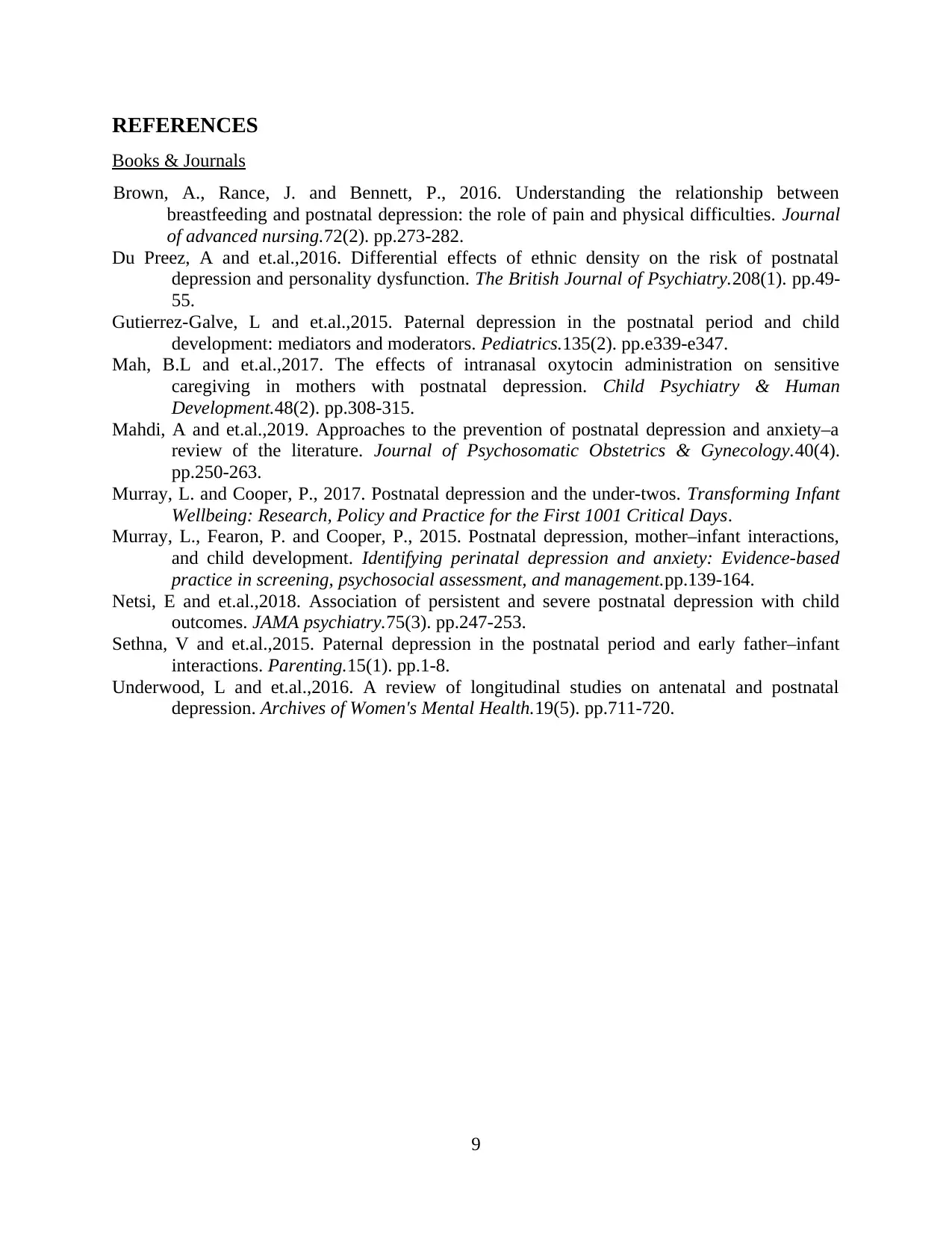
REFERENCES
Books & Journals
Brown, A., Rance, J. and Bennett, P., 2016. Understanding the relationship between
breastfeeding and postnatal depression: the role of pain and physical difficulties. Journal
of advanced nursing.72(2). pp.273-282.
Du Preez, A and et.al.,2016. Differential effects of ethnic density on the risk of postnatal
depression and personality dysfunction. The British Journal of Psychiatry.208(1). pp.49-
55.
Gutierrez-Galve, L and et.al.,2015. Paternal depression in the postnatal period and child
development: mediators and moderators. Pediatrics.135(2). pp.e339-e347.
Mah, B.L and et.al.,2017. The effects of intranasal oxytocin administration on sensitive
caregiving in mothers with postnatal depression. Child Psychiatry & Human
Development.48(2). pp.308-315.
Mahdi, A and et.al.,2019. Approaches to the prevention of postnatal depression and anxiety–a
review of the literature. Journal of Psychosomatic Obstetrics & Gynecology.40(4).
pp.250-263.
Murray, L. and Cooper, P., 2017. Postnatal depression and the under-twos. Transforming Infant
Wellbeing: Research, Policy and Practice for the First 1001 Critical Days.
Murray, L., Fearon, P. and Cooper, P., 2015. Postnatal depression, mother–infant interactions,
and child development. Identifying perinatal depression and anxiety: Evidence-based
practice in screening, psychosocial assessment, and management.pp.139-164.
Netsi, E and et.al.,2018. Association of persistent and severe postnatal depression with child
outcomes. JAMA psychiatry.75(3). pp.247-253.
Sethna, V and et.al.,2015. Paternal depression in the postnatal period and early father–infant
interactions. Parenting.15(1). pp.1-8.
Underwood, L and et.al.,2016. A review of longitudinal studies on antenatal and postnatal
depression. Archives of Women's Mental Health.19(5). pp.711-720.
9
Books & Journals
Brown, A., Rance, J. and Bennett, P., 2016. Understanding the relationship between
breastfeeding and postnatal depression: the role of pain and physical difficulties. Journal
of advanced nursing.72(2). pp.273-282.
Du Preez, A and et.al.,2016. Differential effects of ethnic density on the risk of postnatal
depression and personality dysfunction. The British Journal of Psychiatry.208(1). pp.49-
55.
Gutierrez-Galve, L and et.al.,2015. Paternal depression in the postnatal period and child
development: mediators and moderators. Pediatrics.135(2). pp.e339-e347.
Mah, B.L and et.al.,2017. The effects of intranasal oxytocin administration on sensitive
caregiving in mothers with postnatal depression. Child Psychiatry & Human
Development.48(2). pp.308-315.
Mahdi, A and et.al.,2019. Approaches to the prevention of postnatal depression and anxiety–a
review of the literature. Journal of Psychosomatic Obstetrics & Gynecology.40(4).
pp.250-263.
Murray, L. and Cooper, P., 2017. Postnatal depression and the under-twos. Transforming Infant
Wellbeing: Research, Policy and Practice for the First 1001 Critical Days.
Murray, L., Fearon, P. and Cooper, P., 2015. Postnatal depression, mother–infant interactions,
and child development. Identifying perinatal depression and anxiety: Evidence-based
practice in screening, psychosocial assessment, and management.pp.139-164.
Netsi, E and et.al.,2018. Association of persistent and severe postnatal depression with child
outcomes. JAMA psychiatry.75(3). pp.247-253.
Sethna, V and et.al.,2015. Paternal depression in the postnatal period and early father–infant
interactions. Parenting.15(1). pp.1-8.
Underwood, L and et.al.,2016. A review of longitudinal studies on antenatal and postnatal
depression. Archives of Women's Mental Health.19(5). pp.711-720.
9
⊘ This is a preview!⊘
Do you want full access?
Subscribe today to unlock all pages.

Trusted by 1+ million students worldwide
1 out of 9
Related Documents
Your All-in-One AI-Powered Toolkit for Academic Success.
+13062052269
info@desklib.com
Available 24*7 on WhatsApp / Email
![[object Object]](/_next/static/media/star-bottom.7253800d.svg)
Unlock your academic potential
Copyright © 2020–2025 A2Z Services. All Rights Reserved. Developed and managed by ZUCOL.





